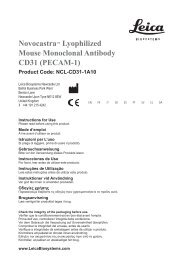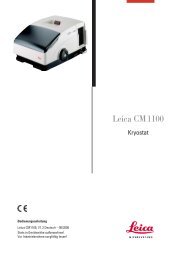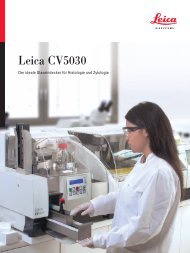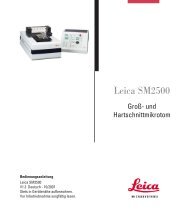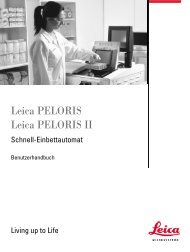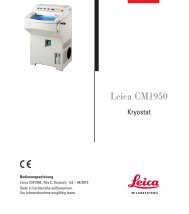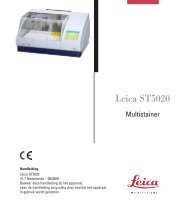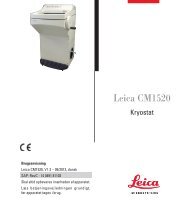Quality Control Differences in tissue processing and technical procedures in the user’s laboratory may produce significant variability in results, necessitating regular performance of in-house controls in addition to the following procedures. Controls should be fresh autopsy/biopsy/surgical specimens, formalin-fixed, processed and paraffin wax-embedded as soon as possible in the same manner as the patient sample(s). Positive Tissue Control Used to indicate correctly prepared tissues and proper staining techniques. One positive tissue control should be included for each set of test conditions in each staining run. A tissue with weak positive staining is more suitable than a tissue with strong positive staining for optimal quality control and to detect minor levels of reagent degradation. 2 Recommended positive control tissue is thyroid. If the positive tissue control fails to demonstrate positive staining, results with the test specimens should be considered invalid. Negative Tissue Control Should be examined after the positive tissue control to verify the specificity of the labeling of the target antigen by the primary antibody. Recommended negative control tissue is tonsil. Alternatively, the variety of different cell types present in most tissue sections frequently offers negative control sites, but this should be verified by the user. Non-specific staining, if present, usually has a diffuse appearance. Sporadic staining of connective tissue may also be observed in sections from excessively formalin-fixed tissues. Use intact cells for interpretation of staining results. Necrotic or degenerated cells often stain non-specifically. 3 False-positive results may be seen due to non-immunological binding of proteins or substrate reaction products. They may also be caused by endogenous enzymes such as pseudoperoxidase (erythrocytes), endogenous peroxidase (cytochrome C), or endogenous biotin (eg. liver, breast, brain, kidney) depending on the type of immunostain used. To differentiate endogenous enzyme activity or non-specific binding of enzymes from specific immunoreactivity, additional patient tissues may be stained exclusively with substrate chromogen or enzyme complexes (avidin-biotin, streptavidin, labeled polymer) and substrate-chromogen, respectively. If specific staining occurs in the negative tissue control, results with the patient specimens should be considered invalid. Negative Reagent Control Use a non-specific negative reagent control in place of the primary antibody with a section of each patient specimen to evaluate non-specific staining and allow better interpretation of specific staining at the antigen site. Patient Tissue Examine patient specimens stained with NCL-L-TTF-1 last. Positive staining intensity should be assessed within the context of any non-specific background staining of the negative reagent control. As with any immunohistochemical test, a negative result means that the antigen was not detected, not that the antigen was absent in the cells/tissue assayed. If necessary, use a panel of antibodies to identify false-negative reactions. Results Expected Normal Tissues Clone SPT24 detected the thyroid transcription factor-1 protein in the nucleus of follicular epithelial cells of the thyroid (13/13), type II pneumocytes and Clara cells of the lung (9/9). Some reactivity was also noted in glial cells in cerebrum (3/3). Clone SPT24 did not stain TTF-1 in a variety of other normal tissues (n=140) including colon (0/12), brain (0/8), placenta (0/4), kidney (0/6), prostate (0/4), testis (0/4), heart (0/4), spleen (0/4), cervix (0/5), lymph node (0/2), thymus (0/13), tongue (0/1), endometrium (0/2), skeletal muscle (0/4), tonsil (0/4), salivary gland (0/4), myometrium (0/1), umbilical cord (0/1), ureter (0/1), bronchus (0/1), ovary (0/4), fallopian tube (0/1), liver (0/4), breast (0/4), esophagus (0/4), stomach (0/4), spinal cord (0/1), eye (0/1), pancreas (0/4), ileum (0/4), cecum (0/1), rectum (0/1), adrenal (0/4), mesothelium (0/1), parathyroid (0/1), peripheral nerve (0/3), pituitary (0/3), bone marrow (0/3), uterus (0/3) and skin (0/4). Abnormal Tissues Clone SPT24 detected the thyroid transcription factor-1 protein in the nucleus of 26/32 lung adenocarcinoma, 4/7 lung small cell carcinoma, 2/3 lung bronchioalveolar carcinoma, 6/6 thyroid papillary carcinoma, 4/4 thyroid medullary carcinoma, 3/3 thyroid follicular carcinoma, 1/1 thyroid follicular adenoma, 1/1 Hashimoto’s thyroiditis, 19/56 thymoma, 1/1 desmoplastic small round cell tumor, 3/38 moderately differentiated colon adenocarcinoma and 1/1 rectal carcinoma. Clone SPT24 did not stain lung squamous cell carcinoma (0/18), lung large cell carcinoma (0/5), poorly differentiated colon adenocarcinoma (0/4), well differentiated colon adenocarcinoma (0/3), ungraded colon adenocarcinoma (0/3), mesothelioma (0/5), small bowel carcinoid (0/4), thymus atypical carcinoid (1/5), metastatic thymic tumor (0/1), breast tumor (0/6), liver tumor (0/8), kidney renal cell carcinoma (0/5), kidney transitional cell carcinoma (0/1), ovary thecoma (0/1), ovary granulosa cell tumor (0/1), ovary juvenile granulosa (0/1), ovary serous carcinoma (0/3), ovary mucinous carcinoma (0/2), ovary germ cell tumor (0/1), ovary clear cell carcinoma (0/1), stomach adenocarcinoma (0/4), pancreas adenocarcinoma (0/2), pancreas papillary mucinous carcinoma (0/1), pancreas islet cell tumor (0/1), pancreas glucagonoma (0/1), testis seminoma (0/3), testis mixed germ cell tumor (0/1), testis embryonal carcinoma (0/1), brain astrocytoma (0/1), brain choroid plexus papilloma (0/1), melanoma (0/3), skin basal cell carcinoma (0/1), skin squamous cell carcinoma (0/2), penis squamous cell carcinoma (0/2), esophagus squamous cell carcinoma (0/2), larynx squamous cell carcinoma (0/1), tongue squamous cell carcinoma (0/2), cervix squamous carcinoma (0/1), small bowel carcinoma (0/1), GIST (0/1), synovial sarcoma (0/1), leiomyosarcoma (0/1), Ewing’s sarcoma (0/1), spindle cell rhabdomyosarcoma (0/1), omental fibrous tumor (0/1), bladder transitional cell carcinoma (0/2), bladder small cell carcinoma (0/1), large B-cell lymphoma (0/1), adrenal oncocytoma (0/2), adrenal adenoma (0/1), ganglioneuroma (0/1), prostate adenocarcinoma (0/1), benign prostatic hyperplasia (0/1), endometrial stromal sarcoma (0/1), endometrial adenocarcinoma (0/1), endometrial clear cell carcinoma (0/1), pheochromocytoma (0/1), paraganglioma (0/1) and cervix tumor (0/2). Thyroid Transcription Factor-1 (clone SPT24) is recommended for the identification of TTF-1 in normal and neoplastic tissues and for use in diagnosis as part of a panel of antibodies. TTF-1-L-CE Page 3
General Limitations Immunohistochemistry is a multistep diagnostic process that consists of specialized training in the selection of the appropriate reagents; tissue selection, fixation, and processing; preparation of the IHC slide; and interpretation of the staining results. Tissue staining is dependent on the handling and processing of the tissue prior to staining. Improper fixation, freezing, thawing, washing, drying, heating, sectioning or contamination with other tissues or fluids may produce artifacts, antibody trapping, or false negative results. Inconsistent results may be due to variations in fixation and embedding methods, or to inherent irregularities within the tissue. 4 Excessive or incomplete counterstaining may compromise proper interpretation of results. The clinical interpretation of any staining or its absence should be complemented by morphological studies using proper controls and should be evaluated within the context of the patient’s clinical history and other diagnostic tests by a qualified pathologist. Antibodies from <strong>Leica</strong> <strong>Biosystems</strong> Newcastle Ltd are for use, as indicated, on either frozen or paraffin-embedded sections with specific fixation requirements. Unexpected antigen expression may occur, especially in neoplasms. The clinical interpretation of any stained tissue section must include morphological analysis and the evaluation of appropriate controls. Bibliography - General 1. National Committee for Clinical Laboratory Standards (NCCLS). Protection of laboratory workers from infectious diseases transmitted by blood and tissue; proposed guideline. Villanova, P.A. 1991; 7(9). Order code M29-P. 2. Battifora H. Diagnostic uses of antibodies to keratins: a review and immunohistochemical comparison of seven monoclonal and three polyclonal antibodies. Progress in Surgical Pathology. 6:1–15. eds. Fenoglio-Preiser C, Wolff CM, Rilke F. Field & Wood, Inc., Philadelphia. 3. Nadji M, Morales AR. Immunoperoxidase, part I: the techniques and pitfalls. Laboratory Medicine. 1983; 14:767. 4. Omata M, Liew CT, Ashcavai M et al. Nonimmunologic binding of horseradish peroxidase to hepatitis B surface antigen: a possible source of error in immunohistochemistry. American Journal of Clinical Pathology. 1980; 73:626. 5. Berghmans T, Mascaux C, Martin B et al. Prognostic role of thyroid transcription factor-1 in stage III non-small cell lung cancer. Lung Cancer. 2006; 52(2): 219-224. 6. Penman D, Downie I, Roberts F. Positive immunostaining for thyroid transcription factor-1 in primary and metastatic colonic adenocarcinoma: a note of caution. Journal of Clinical Pathology. 2006; 59:663-664. 7. Comperat E, Zhang F, Perrotin C et al. Variable sensitivity and specificity of TTF-1 antibodies in lung metastatic adenocarcinoma of colorectal origin. Modern Pathology. 2005; 18(10):1371-1376. 8. Pan C-C, Chen PC-H, Tsay S-H et al. Cytoplasmic immunoreactivity for thyroid transcription factor-1 in hepatocellular carcinoma: a comparative immunohistochemical analysis of four commercial antibodies using a tissue array technique. American Journal of Clinical Pathology. 2004; 121(3):343-349. Amendments to Previous Issue Total Protein Concentration, Recommendations On Use, Results Expected, Bibliography - General. Date of Issue 07 May 2013 TTF-1-L-CE Page 4



